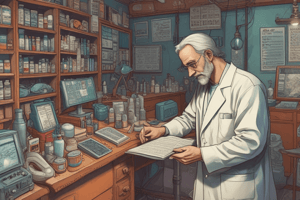Podcast
Questions and Answers
What is the primary goal of preventive analgesia?
What is the primary goal of preventive analgesia?
- To minimize the risk of chronic pain development (correct)
- To improve patient satisfaction
- To reduce opioid consumption
- To decrease postoperative pain
Which type of pain is characterized by damage to the nervous system?
Which type of pain is characterized by damage to the nervous system?
- Nociceptive pain
- Psychopathic pain
- Non-nociceptive pain
- Neuropathic pain (correct)
What is the main characteristic of Complex Regional Pain Syndrome (CRPS) Type I?
What is the main characteristic of Complex Regional Pain Syndrome (CRPS) Type I?
- Inflammation or tissue damage
- Previous surgical history
- No apparent nerve damage (correct)
- Nerve injury or damage
What is the primary mechanism of action of COX-1 and COX-2 inhibitors?
What is the primary mechanism of action of COX-1 and COX-2 inhibitors?
Which type of fibers transmit nociceptive information to the spinal cord from their free nerve endings?
Which type of fibers transmit nociceptive information to the spinal cord from their free nerve endings?
What is the primary goal of multimodal analgesia in pain management?
What is the primary goal of multimodal analgesia in pain management?
Which of the following is a non-opioid drug used for neuropathic pain syndromes?
Which of the following is a non-opioid drug used for neuropathic pain syndromes?
What is the term for the increased sensitivity of pain receptors to stimulation after tissue injury or inflammation?
What is the term for the increased sensitivity of pain receptors to stimulation after tissue injury or inflammation?
What is the primary challenge in managing chronic pain?
What is the primary challenge in managing chronic pain?
What is the percentage of adults suffering from high-impact chronic pain?
What is the percentage of adults suffering from high-impact chronic pain?
Study Notes
Pain Management and Neuroplasticity
- Neuroplastic changes in the nervous system occur due to tissue injury, leading to sensitization.
- Extensive analgesic coverage, including both surgical and postsurgical periods, is crucial for effective pain management.
Opioid-Sparing Multimodal Pharmacotherapy
- Respiratory depression can be decreased by using opioid-sparing multimodal pharmacotherapy, regional anesthesia, and continuous monitoring of the patient with pulse ox and capnography.
- NSAIDS inhibit COX 1 and 2, converting arachidonic acid to prostaglandins.
Opioid-Dependent Patients
- Opioid-dependent patients require a multimodal approach, including regional anesthesia, nonopioid analgesics, and opioid analgesics.
- Maintaining an adequate dose of opioid is necessary to avoid precipitating withdrawal symptoms.
Nociceptor Pain Transmitters
- A delta and C fibers are nociceptor pain transmitters.
- A beta fibers normally transmit non-noxious information but also participate in nociceptive transmission.
Neuropathic Pain Syndromes
- Antidepressants and anticonvulsants are effective for treating neuropathic pain syndromes.
- Anticonvulsants are the first-line treatment due to their favorable side-effect profile and speed of therapeutic effect.
Complex Regional Pain Syndrome (CRPS)
- Regional sympathetic dystrophy (I) and causalgia (II) are the two types of CRPS.
- Type I is more difficult to diagnose, as there is no evidence of peripheral nerve injury.
- There is preceding nerve injury in CRPS II.
Types of Pain
- Somatic and visceral pain are forms of nociceptive pain due to stimulation of specific nociceptors.
- Neuropathic pain is nonnociceptive pain due to peripheral or central neural structures.
Pain Physiology
- Transduction, transmission, perception, and modulation describe pain physiology.
- Wind up results from chronic pain and is due to repetitive stimulation from chronic inflammation or nerve damage.### Chronic Pain
- Delirium, opioid tolerance, and hyperalgesia are potential consequences of chronic pain
- Increased hospital stay and low patient satisfaction are also common outcomes
- Chronic pain can lead to central sensitization, psychiatric conditions, and implants/devices
Definition and Types of Pain
- Pain is an unpleasant sensory and emotional experience associated with actual or potential tissue damage
- There are two main types of pain: acute and chronic
- Acute pain is based on longevity and can be nociceptive or non-nociceptive
- Chronic pain persists beyond normal healing time and can be neuropathic, nociceptive, or inflammatory
- Nociceptive pain is caused by stimulation of specific nociceptors, which can be somatic (localized and sharp) or visceral (diffuse and referred)
- Non-nociceptive pain is caused by damage to peripheral or central neural structures and can be characterized by abnormal processing of painful stimuli
Neuropathic Pain vs Nociceptive Pain
- Neuropathic pain is persistent and can occur even after inflammation has resolved
- Nociceptive pain improves with inflammation resolution
- Allodynia (pain from stimuli that do not normally cause pain) is a characteristic of neuropathic pain
- NSAIDs are often ineffective in treating neuropathic pain
Pain Stimulation
- Pain stimulation can be categorized into three subdivisions:
- Painful stimulation without tissue damage
- Tissue damage without nerve damage
- Nerve damage
Pain Physiology
- The pain process involves four stages: transduction, transmission, perception, and modulation
- Transduction is the conversion of noxious stimuli into an electrical impulse
- Transmission involves the transmission of the pain impulse from the periphery to the central nervous system
- Perception involves the interpretation of the pain impulse by the brain
- Modulation involves the regulation of pain transmission and perception by the brain and spinal cord
Pain Pathophysiology
- Chronic pain can lead to dysfunction in peripheral, spinal, and cerebral regions
- Abnormal neural activity and changes in ion channel expression can contribute to chronic pain
- Addressing all areas of pain physiology is necessary for effective pain management
Types of Chronic Pain
- Psychogenic pain is pain without an identified physical cause
- Nociceptive pain is caused by tissue damage or inflammation
- Neuropathic pain is caused by damage to the somatosensory nervous system
- Chronic postsurgical pain is pain that persists after surgery
- Wind-up is the evolution of chronic pain from repetitive stimulation
Chronic Postsurgical Pain (CPSP)
- CPSP is a type of chronic pain that develops after surgery
- Risk factors include type of surgery, preoperative pain, and certain demographic factors
- Prevention of CPSP involves addressing underlying causes of pain, using regional anesthesia, and providing adequate postoperative pain management
Wind-Up
- Wind-up is the progression of chronic pain from acute pain
- It involves repetitive stimulation of nociceptors, leading to increased neuronal excitability and pain sensitivity
- Prevention of wind-up involves addressing underlying causes of pain and providing adequate pain management
Treatment of Chronic Pain
- Treatment of chronic pain involves a multidisciplinary approach, including medications, interventional procedures, and rehabilitative therapies
- Goals of treatment include improving function, reducing pain, and improving quality of life
- Medications used to treat chronic pain include NSAIDs, acetaminophen, opioids, antidepressants, and anticonvulsants
Pharmacology
- NSAIDs inhibit prostaglandin synthesis and have anti-inflammatory and analgesic effects
- Acetaminophen is a non-opioid analgesic that inhibits pain processing centrally
- Opioids bind to opioid receptors in the CNS and have analgesic effects
- Antidepressants and anticonvulsants can be used to treat certain types of chronic pain
Additional Options
- Muscle relaxants, topical anesthetics, and benzodiazepines can be used to treat chronic pain
- Cannabinoids and buprenorphine-naloxone may be effective for certain types of chronic pain
- Implantable devices, such as spinal cord stimulators, can be used to treat chronic pain that is refractory to other treatments### Pain Management
Objectives
- Define pain
- Distinguish between nociceptive and non-nociceptive pain
- Define chronic pain
- Describe pain physiology: transduction, transmission, perception, modulation
- Describe pain pathophysiology
- Define types of chronic pain: psychopathic, nociceptive, neuropathic, post-surgical pain syndrome, wind-up
- Distinguish types of neuropathic pain, specifically CRPS Type I and Type II
Importance of Pain Management
- Estimated 50 million adults suffer from chronic pain
- 19.6 million of those experience high-impact chronic pain, limiting quality of life and work activities
- Opioid crisis: challenge of alleviating pain while reducing opioid misuse/abuse
- CRNAs: experts in pain management
- Pain management considered the "Fifth vital sign" since the 1990s
Pain Physiology and Pathophysiology
- Transduction: process of detecting noxious stimuli
- Transmission: transmission of pain signals to the spinal cord
- Perception: interpretation of pain signals by the brain
- Modulation: regulation of pain signals by the brain and spinal cord
Types of Chronic Pain
- Nociceptive pain: caused by tissue damage or inflammation
- Neuropathic pain: caused by nerve damage or dysfunction
- Psychopathic pain: not associated with tissue damage or inflammation
- Post-surgical pain syndrome: chronic pain after surgery
- Wind-up: prolonged and increased sensitivity to painful stimuli
Neuropathic Pain
- CRPS Type I: occurs without nerve damage
- CRPS Type II: occurs with nerve damage
- Non-opioid drugs used to treat neuropathic pain syndromes
Nociceptive Pain
- Caused by tissue damage or inflammation
- Types: somatic, visceral, and referred pain
Non-Nociceptive Pain
- Not associated with tissue damage or inflammation
- Examples: psychogenic pain, fibromyalgia
Multimodal Analgesia and Anesthetic Management
- Combination of different analgesic modalities to manage pain
- Perioperative anesthetic management of patients with chronic pain
CRNAs Role in Advanced Pain Management
- Experts in pain management
- Involved in developing and implementing pain management plans
Studying That Suits You
Use AI to generate personalized quizzes and flashcards to suit your learning preferences.
Related Documents
Description
This quiz covers the principles of pain management and analgesia in nervous system injuries, including neuroplastic changes, sensitization, and pharmacological interventions. It also discusses the importance of multimodal therapy and continuous patient monitoring.




